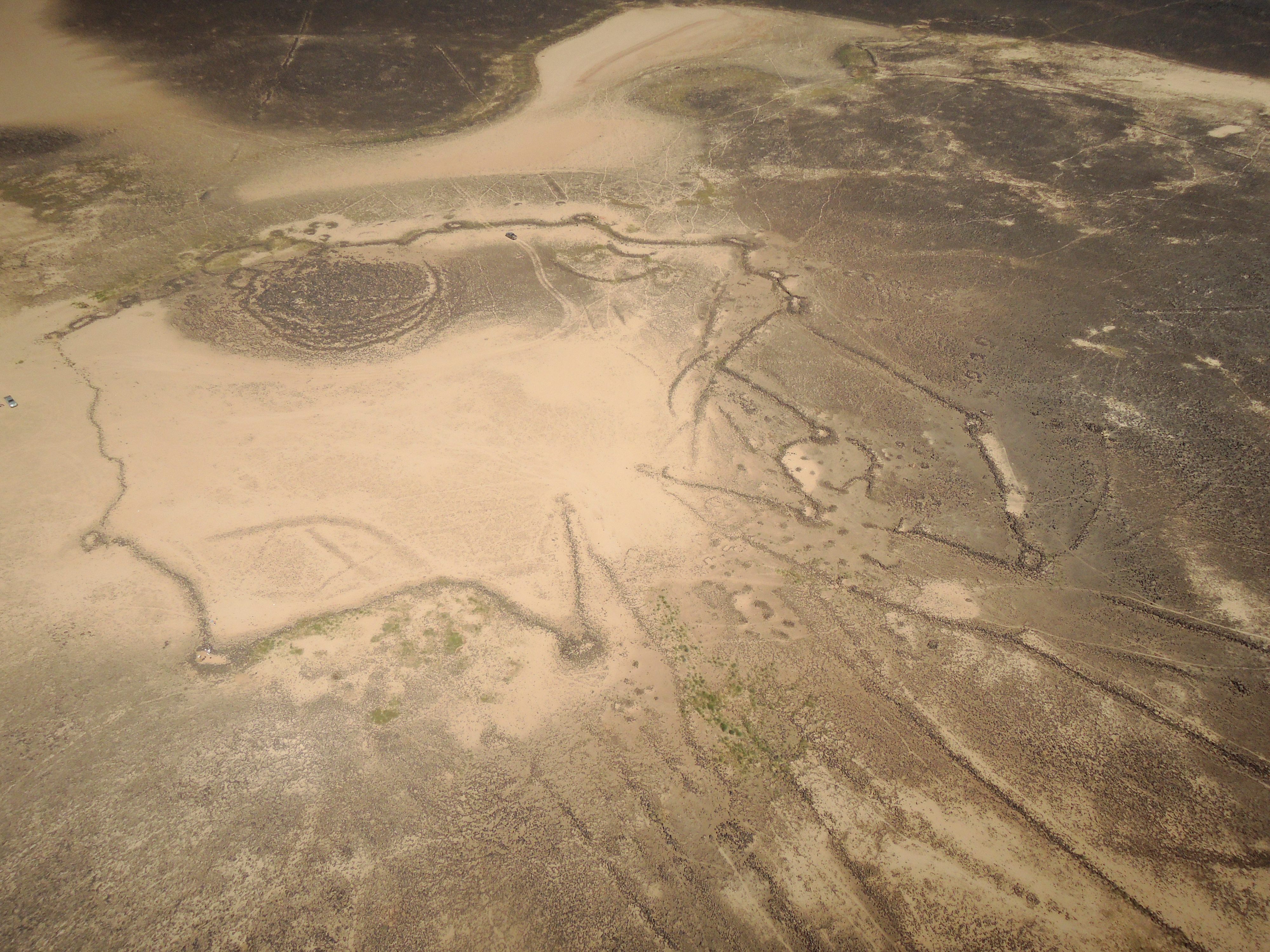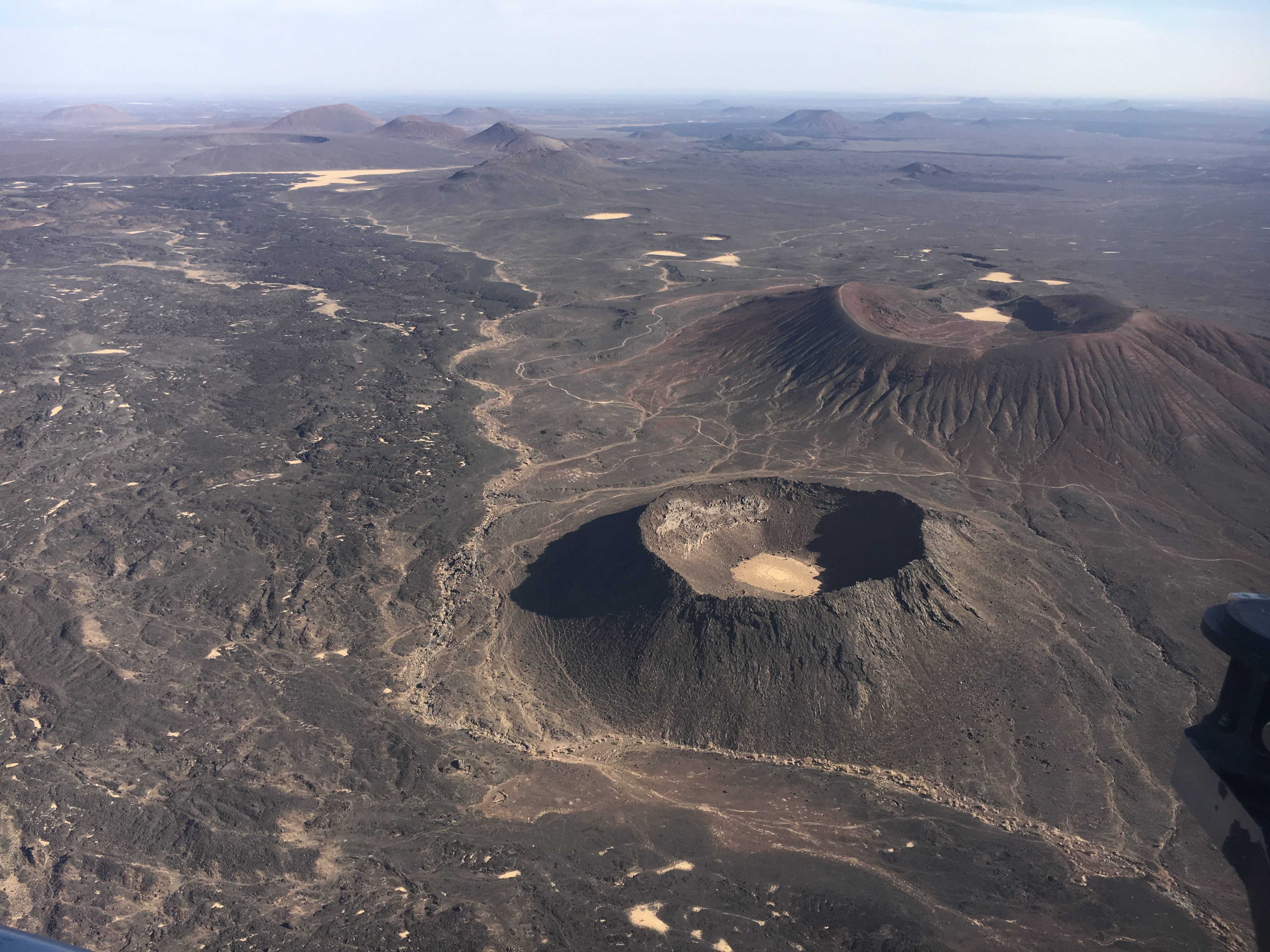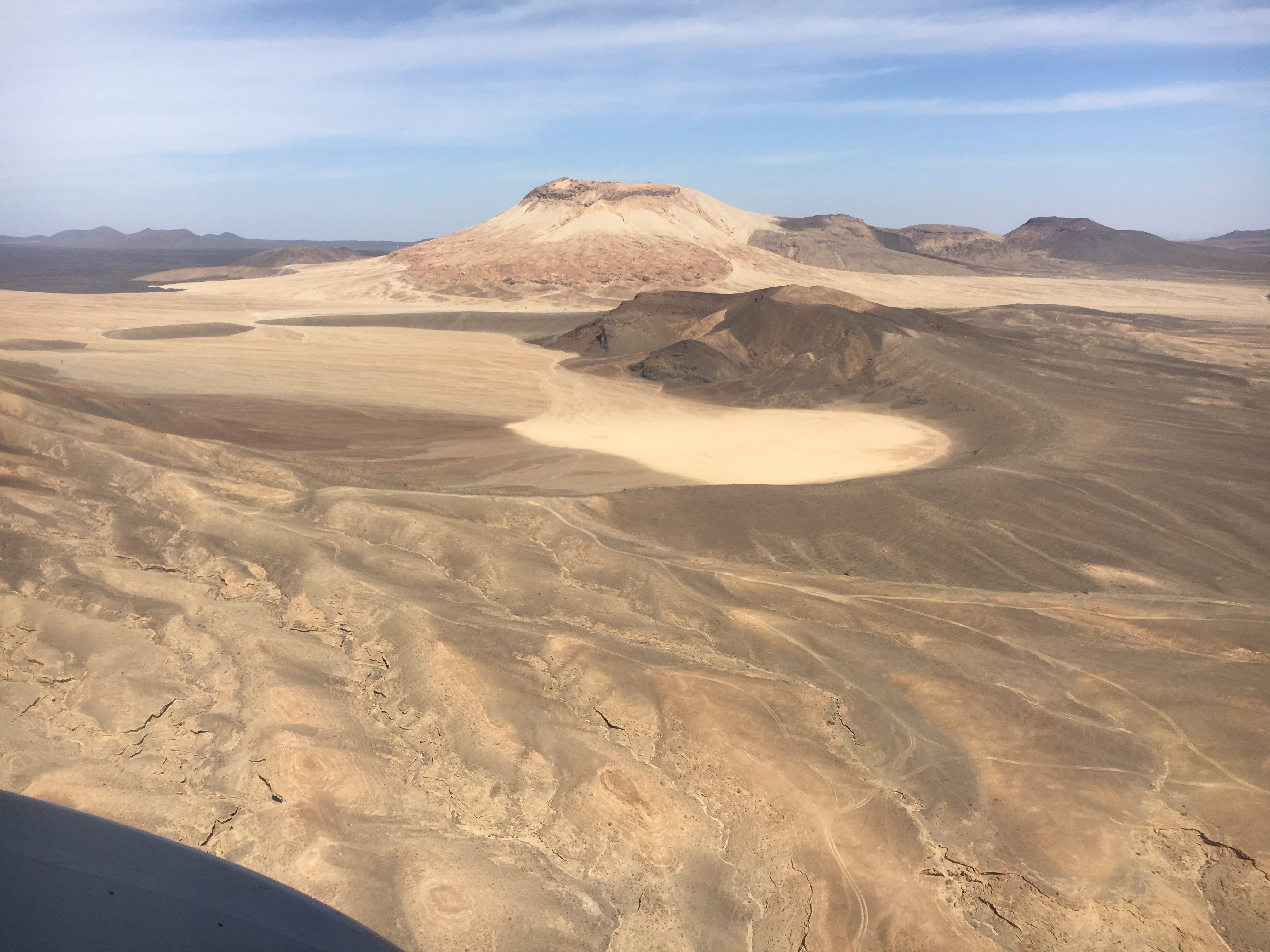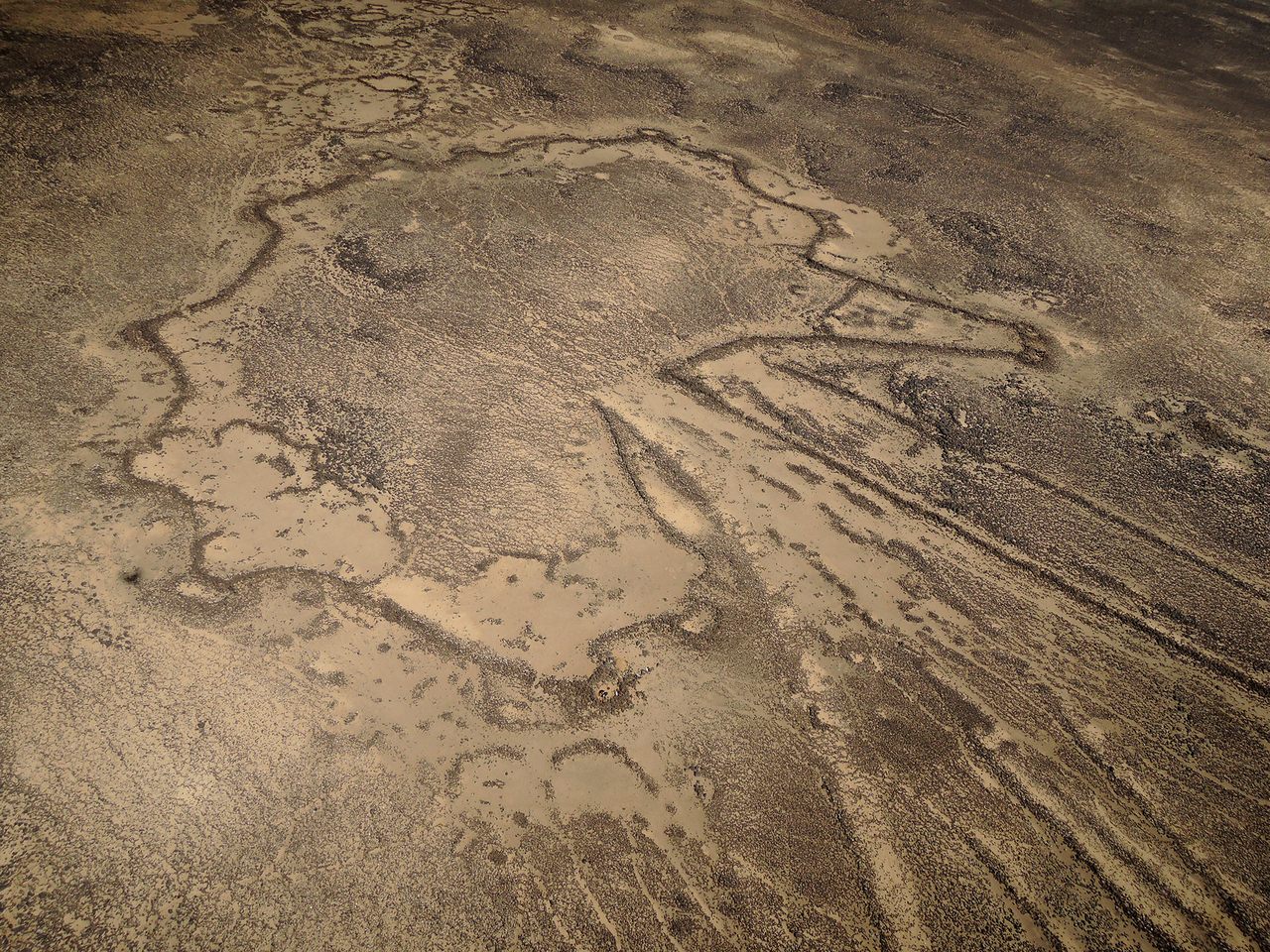The Middle East Is Dotted With Thousands of Puzzling Kite-Shaped Structures
Some of them are comparable in size to the famous Nazca Lines in Peru.
In late 2017, it was announced that 400 elongated, stone-built structures, some the size of football fields, had been seen within Saudi Arabia’s inhospitable Harrat Khaybar, one of several volcanic fields (harrats) scattered throughout the Arabian Peninsula. The identification of these so-called “gates,” some of which may be up to 9,000 years old, generated significant media coverage. According to the New York Times, “Google Earth has unlocked the gates to ancient mysteries around the world,” with these recently discovered structures, largely classified via satellite imagery, being the latest example of the power of archaeology from above.
These gates, however, are just one chapter of a far grander tale, one involving wild animals, climate change, volcanic eruptions, and a society of people whose identities are still highly elusive. “What’s really fascinating to me,” says Michael Petraglia, professor of human evolution and prehistory at the Max Planck Institute for the Science of Human History, “is that structures like these occur throughout the Middle East.” In other words, the gates aren’t the only notable ancient constructions of this ilk in the region. These other enormous stone structures, comparable in size to the famous Nazca lines in the Andes, are known as “kites.”

Thanks to aerial surveys, satellite imagery, and reports by those on the ground, researchers know that there are thousands of kites throughout the Arabian Peninsula, and even as far afield as Kazakhstan and Uzbekistan. Over time, it has emerged that the origin story of the kites stretches across many thousands of years of ancient human history, but three major questions remain: What were they used for, how old are they, and who built them?
Although these structures have been spoken of for some time by people who still live in the region, one of the first known written descriptions of them comes courtesy of the British Royal Air Force’s Flight-Lieutenant Percy Maitland, who serendipitously saw them a few years after the end of the First World War.
By the 1920s, much of the Middle East had been carved up in an agreement between the British and the French. While attempting to fend off revolts and revolutions in Iraq and Egypt, the RAF continued to fly between Baghdad and Cairo, to both chart the region and to deliver the post.
In an aerial surveillance report from 1927, Maitland describes seeing stone walls, both in lines and in radiating, more circular patterns, around 120 miles east of the Dead Sea in old lava fields. The nomadic Bedouin, he says, call them “The Works of the Old Men.” Maitland says that the structures are “very complicated and difficult to understand.” He mentions that the Arabs attribute them to Christians, which implies they are pre-Islam. “They certainly have the appearance of being of great antiquity,” he writes. The RAF came to call these structures “kites, because that’s what they looked like from above.

Over time, archaeologists began probing these kites up close. It became clear that they came in all shapes and sizes, and are often found with artifacts, ranging from cattle-depicting rock art to stone tools. Some feature cairns, which are potentially funereal structures. Describing many of them as “substantial,” Petraglia explains that there’s been a lot of time and effort dedicated to them. “There’s a real community-level feel to all these kites,” he says.
Rémy Crassard, an archaeologist at the French Center for Archaeology and Social Sciences in Kuwait, explains that in the 1990s, just a few hundred kites were estimated to exist. Now, we know that there are at least 6,000, from Saudi Arabia to the Sinai Peninsula. This is thanks to not just aerial surveys, but initiatives like the Globalkites project, of which Crassard is the leader, which studies the structures using both satellite imagery and fieldwork.
It turns out that the densest concentration of kites can be found in the Syrian and Jordanian part of the Fertile Crescent, a once-wet and vegetation-dense part of the region where some of humanity’s first civilizations arose. The density of kites decreases as you head into Armenia and Turkey, and up through Central Asia, although it’s not clear why this is the case.
The ages of the kites have long been ambiguous, but volcanic activity may provide a clue here. Károly Németh, an associate professor of geology at New Zealand’s Massey University, explains that the slow tearing apart (or rifting) of the region has fueled much of the volcanic activity in this part of the Middle East, and has produced numerous harrats which are home to many of the kites.

Today, seen from space, the harrats look positively Martian. They are pockmarked with small volcanic hills named scoria cones, frozen lava lakes, and explosively-generated pits named maar craters. Geochemical compositions vary, meaning the fields can be as dark as night or near-perfectly white.
Some harrats date back 30 million years, long before humanity made its debut. Conversely, in gate-riddled Harrat Khaybar, lava was still flowing until just 1,000 years ago. Archaeological evidence shows that people lived alongside these later eruptions, with some of these structures having actually had lava flow over them. This means that loose ages of some of them could be ascertained.
Crassard and his colleagues, considering this option, hoped to nevertheless get a more precise chronology. To wit, they dug around in some of the pits found within these kites, and uncovered plenty of animal remains.
Using multiple dating methods, they found that some of the kites in Jordan date back to the Neolithic period, maybe as early as 9,000 years ago. They are “much older than we expected,” Crassard explains. He adds that, as these kites get further away from the Fertile Crescent, they also appear to get younger.
These pits also hinted at what may be, in many cases, the kites’ purpose. In Arabia, Crassard’s team found gazelle remains; in Armenia, donkeys and goats; and in Kazakhstan and Uzbekistan, saiga. They suspected that these kites were used by hunters to corral and trap herds of animals, and when they got stuck in those pits, they couldn’t get out, and were slaughtered en masse.
This idea has been suggested before by other researchers, based on other archaeological evidence. For example, kites in Jordan seem oriented in such a way in which to intercept animal migration toward Syria. There are also eyewitness accounts of explorers, including the adventurer John Burckhardt, who in an 1831 tome describes a gazelle hunt in what was probably Syria. The people scared the gazelle into these kites, he wrote, sometimes by the hundreds. It’s also possible that cattle were simply confined within these kites, much like they are on farms today.
Petraglia, however, notes that the region’s kites aren’t all designed to one specification. Some have a very standardized function, while others are quite superficially distinct. Crassard agrees, explaining that his Globalkites team has used statistical and mathematical models to map things the kites do or do not have in common with each other. Details will be revealed in upcoming publications, but it’s clear that although many are idiosyncratic, similarities in their designs are frequent.

Clues to their design may reside in the shifting climate, which changed dramatically while the kites were built.
Petraglia is part of the Palaeodeserts project, which is documenting one million years of environmental change in the Arabian Desert. He explains that from 10,000 to 6,000 years ago, humans there lived in the Early Holocene Wet Phase. Back then, the area was peppered with oases. It was more humid, a time marked by more rainfall, more lakes, and, says Petraglia, a “whole network of rivers across Arabia.” Vegetation was a common sight, and agriculture and animal husbandry were practiced by pastoralists and sedentary people. “It was a much richer environment, in terms of resources,” he adds.
Hugo Murcia, a geologist at the University of Caldas in Colombia, notes that the volcanic debris left behind here clearly shows magma interacting with water—another clear sign that the area was once flowing with the stuff. “You can only imagine how beautiful these volcanoes would have been during the wet periods, with rivers and animals weaving around them,” says Petraglia.
More significantly, previous archaeological work has revealed that these kites are at least as old as the transition period from this wet phase to the contemporary hyper-arid phase. That suggests that the function of these structures may have changed over time as humans adapted to the changing environment—but at present, it’s extremely difficult to say how.
“We haven’t told that story at all,” Petraglia says.

It doesn’t help, of course, that we still have no real idea who built the kites in the first place. Although it’s a huge misconception that people simply disappeared when the sand dunes arrived—people have always been living in Arabia, Petraglia emphasizes—the identities of the “Old Men” that Maitland referenced remain unknown.
Lava tubes, underground caverns formed by lava flows, also criss-cross throughout the region, and Petraglia hints that human remains might be found in some of them. These potential tombs are going to be excavated by Petraglia and his colleagues for the first time in early 2019, possibly shedding some light on this archaeological gap.
When asked who may have lived near the oldest kites, Crassard suggests that perhaps they were nomads, who came to these increasingly arid regions when animal prey migrated through the area. Alternatively, those hunters may have lived there all the time. “We have no idea,” he says.

The gates are perhaps even older than the kites: Although they remain segregated from the kites, there is at least one instance of a kite tangled up and perhaps sitting atop a gate. Like the kites, the gates are clearly visible from space; they were initially spotted by the Desert Team, a group of Saudi amateur archaeologists, via satellite imagery. This was then followed up by work led by David Kennedy, a professor of archaeology at the University of Western Australia, who wrote in his November 2017 paper that these gates were found exclusively within “bleak, inhospitable lava fields.” Little else is known about them.
Huw Groucutt, a postdoctoral fellow at the University of Oxford’s School of Archaeology, calls the gates both “very interesting” and “very strange.” He says he “cannot see any clear ‘functional’ purpose, so surely they are some kind of site where ritual activities of some kind took place,” but adds, “who knows what those could be.”
The only way forward for both the gates and kites is to conduct more systematic fieldwork of all kinds. “The area is one of the most amazing archaeological, volcanological, and cultural sites in the world,” Németh says. “It’s also under-researched.”
Important advances about the kites have certainly been made over the last few decades but compared to the hundreds of archaeological endeavors taking place in, say, Europe at any one time, there’s a pitiful amount happening in Arabia, says Petraglia. “The media might like to call the structures ‘mysterious’,” he explains, “but that’s just because archaeologists haven’t done their work yet.”

























Follow us on Twitter to get the latest on the world's hidden wonders.
Like us on Facebook to get the latest on the world's hidden wonders.
Follow us on Twitter Like us on Facebook